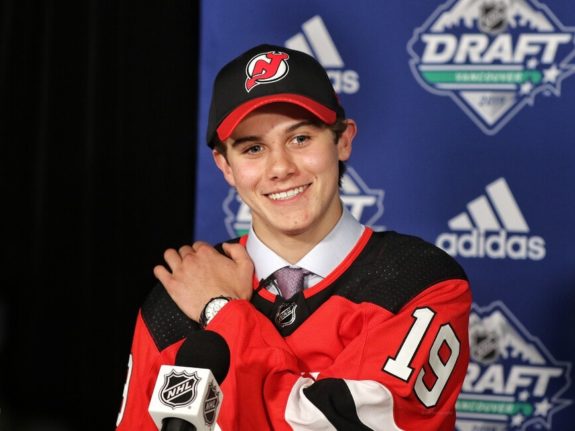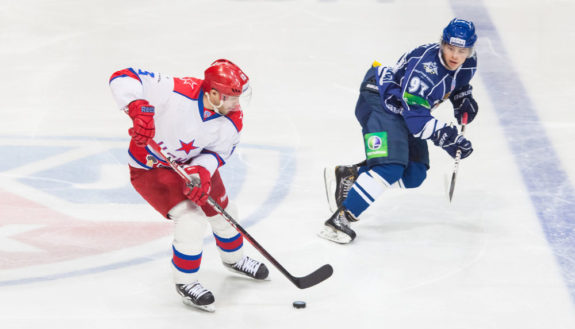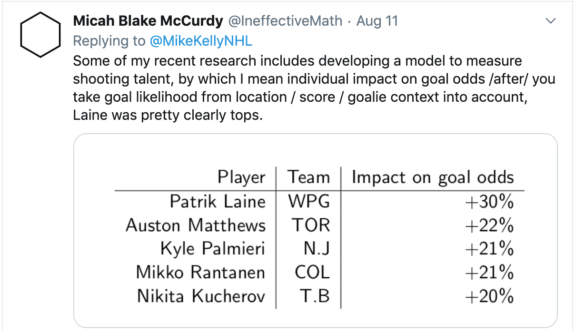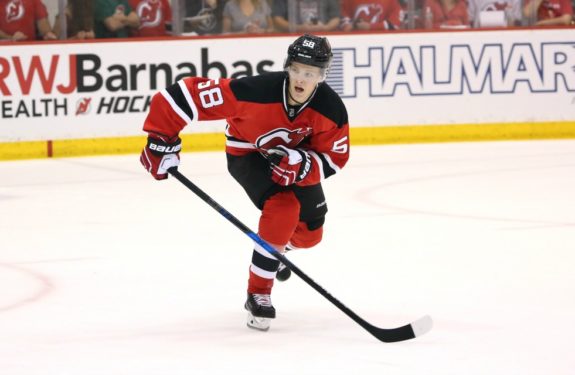The New Jersey Devils’ lineup will look much different when preseason hockey begins in a little over a month. They had one of the most active offseasons of any NHL team, adding plenty of talent to the roster, but especially at forward.
They started by selecting center Jack Hughes with the first overall pick at the Entry Draft. A little over a week later, they signed right winger Wayne Simmonds during free agency. Their last significant addition came when they acquired left-wing Nikita Gusev from the Vegas Golden Knights in exchange for a couple of draft picks at the end of July.

They have a much deeper group of forwards than a season ago, and things seem to be set, barring another major trade. So what are some potential line combinations? Using Sean Tierney’s WAR Lineup Creator, I put together a few different scenarios of some possible matches for the start of 2019-20.
WAR Lineup Overview
Before getting into things, let’s go over the WAR Lineup Creator. You may have heard of WAR before, especially if you’re a baseball fan. It stands for wins above replacement and shows how many wins a player adds to his team relative to a replacement-level player. And the same is true when applied to hockey.
For this post, I won’t be looking at a specific player’s WAR. Rather, I’ll be focusing on how to get the best combos based on an entire line’s projected full season war (ProjFSW). Fortunately, Tierney’s lineup tool provides ProjFSW using Evolving Hockey’s WAR model. It’s also important to note that a team’s top two lines make up for 70% of ice time, while the bottom six makes up for the remaining 30%. With that taken care of, let’s get into the potential combos.
Scenario 1: Hall, Hischier, Palmieri Stick Together
The Devils stack their top line with Taylor Hall, Nico Hischier, and Kyle Palmieri. That leads to a second line with Gusev, Hughes, and Jesper Bratt. Simmonds finds himself with Travis Zajac and Blake Coleman, while the fourth line is rounded out by Miles Wood, Pavel Zacha, and Jesper Boqvist.

The trio of Hall, Hischier, and Palmieri has put up dominant five-on-five results since Hischier entered the league in 2017. They have a Corsi for percentage (CF%) of 52.84% and expected goals for percentage (xGF%) of 54.2%. And that’s to go along with a plus-20 goal differential (41-21) when on the ice together.
It’s tough to argue with those results, but plenty of problems arise keeping them together. Their ProjFSW of 9.0 is great, but the other three lines ProjFSW comes out to a combined 4.6. In other terms, the Devils would have no depth. A line of Gusev, Hughes, and Bratt has potential. But that’s three pass-first players, so one of them would have to become a shooter.

The Devils’ bottom-six would need some help, too. Simmonds is still a capable third-liner offensively, but he struggles on defense. And that’s a problem when paired with Zajac and Coleman since both will be going against the opposition’s top lines regularly.
The fourth line has potential but in a boom-or-bust kind of way. Wood and Zacha had terrible starts to 2018-19, but each finished the season strong. Boqvist is one of the team’s top prospects and has the ceiling of a second-line forward. But he may be best suited for a smaller role while getting used to North American ice. His 2018-19 SHL (Sweden) production would translate to 32 points in the NHL, so this could make for a solid fourth line, depending on how Wood and Zacha perform.
Scenario 2: Unleashing Gusev
Gusev was the KHL’s leading scorer in 2018-19, finishing with 82 points in 62 games, which projects to 79 points in 82 NHL games. Head coach John Hynes feels comfortable giving him a top role, placing him with Hall and Hischier on the first line. That bumps Palmieri down to the second line, with Hughes and Bratt. The bottom six remains largely the same, with Wood and Simmonds swapping spots.

Gusev is a natural left-wing, but he’s played right wing before and has expressed being open to playing it in the NHL. It also helps that he’s a right-handed shot, which could make the transition easier. Placing him on the first line isn’t much of a downgrade to Palmieri (9.0 ProjFSW to 8.3). However, the key is the balance it gives to the Devils’ second line.
Hughes and Bratt needed a goal-scorer in scenario one, and Palmieri gives them that. He fired 224 shots on goal in 74 games last season and shoots at 12.4% for his career. Shooting talent is hard to come by, and Palmieri is one of the best in the league, so he’d be a great fit for pass-first players like Bratt and Hughes.

Swapping Wood and Simmonds in the bottom six might not seem like a big deal, but Wood has played well with Zajac and Coleman. The three of them logged 275 minutes together in 2018-19 and had a 52.01 CF% and 52.45 xGF%. So it wouldn’t be a surprise to see them get a shot together when the season begins.
Related: Devils Need to Find the Right Role for Simmonds
It may seem like an odd choice to have Simmonds, who’s making $5 million next season, on the fourth line. But his play has declined quite a bit since 2015-16, the best season of his career, so a fourth-line role may be the best fit for him. He’d play with a top defensive forward in Zacha but could still generate some offense with a more skillful Boqvist. Simmonds is also sure to get plenty of power-play minutes, which is where he’ll provide the most value.
Scenario 3: Evening Out the Top Six
To balance out the top six, the Devils pair Bratt with Hischier and Hall. Palmieri remains on the second line, but with Hughes and Gusev. Boqvist moves up to the third line with Coleman and Zajac, while Wood, Zacha, and Simmonds form the fourth line.

Bratt has positive results with Hall and Hischier over the last two seasons. They’ve played almost 400 minutes together and have a 53.58 xGF%, and they’ve controlled a majority of the scoring and high-danger chances. Bratt showed noticeable improvement in 2018-19 before his season was cut short by an injury, so it makes sense to give him a shot on the top line.
The second line of Gusev, Hughes, and Palmieri screams potential. And it’s no surprise they have the highest ProjFSW of the second lines mentioned here. Palmieri is the perfect fit for Hughes and Gusev. He provides the shooting threat that they need to be successful as they get used to playing in the NHL. If they find chemistry quickly, they could produce first-line scoring rates.
It’s pretty clear, at this point, that Zajac and Coleman shouldn’t be broken up. It’s just a matter of who’ll be playing alongside them. It may take time for Boqvist’s defensive game to come around, especially as a 21-year-old. But he could help facilitate offense with Zajac and Coleman, who are capable scorers themselves. If Boqvist shows he can do so without being a defensive liability, this could be a steady two-way third line.

Every team needs a line with some size and edge. Pairing Wood, Zacha, and Simmonds together could give the Devils that. Simmonds would be the smallest player, at 6-foot-2, 185 pounds, but he doesn’t shy away from physical play. All three players can contribute a bit of offense, too. Their 0.1 ProjFSW isn’t great, but they could outperform it if all three players bounce back from tough seasons.
Hynes Has Options
There are plenty of ways to mix and match players to find the right lines. Hynes’ roster is deep enough where he has options now, unlike previous seasons. However, there are a couple of things to consider when trying to find the right fits.
The first is keeping Simmonds out of the top six. I understand the rationale for trying it out, especially if Hynes wants some protection for smaller players like Hughes or Gusev. But Simmonds’ play has been declining for a few seasons, and he could have a hard time keeping up in a more skillful top six.
Related: Devils’ Busy Offseason Rolls on with Gusev Trade
The second thing to consider is pairing Palmieri with Hughes. Finding a left-winger won’t be hard with Bratt, Gusev, and even Boqvist as options. But none of those three are the shooting threat Palmieri is. It’s also tough to draw up a scenario where Palmieri is on the first line without giving the team depth problems. So pairing him with Hughes benefits everyone.
The main takeaway from this is the Devils’ offense should be much better than last season. Will it be good enough to return to the playoffs? Time will tell. But a healthy Hall — along with the additions of Hughes, Simmonds, and Gusev — give it the potential to be. Add contributions from Boqvist, and role players like Wood and Simmonds, and the Devils could be deep enough to roll four lines.
* * *
Advanced Stats from Natural Stat Trick. Lineups created via Sean Tierney’s (@ChartingHockey) WAR Lineup Tool.